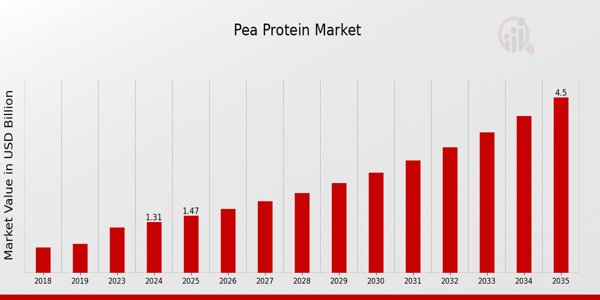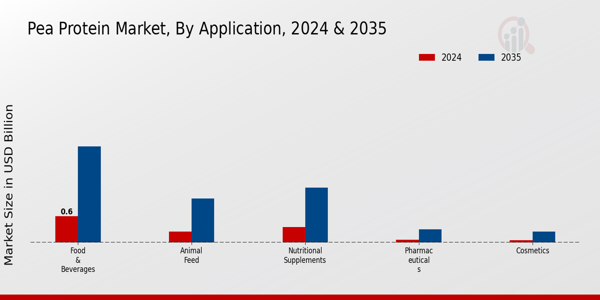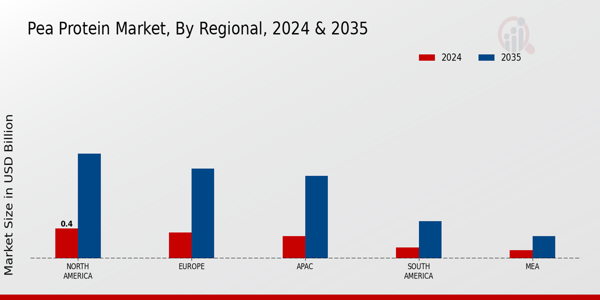Pea Protein Market Overview
As per MRFR analysis, the Pea Protein Market Size was estimated at 1.17 (USD Billion) in 2023. The Pea Protein Market Industry is expected to grow from 1.31(USD Billion) in 2024 to 4.5 (USD Billion) by 2035. The Pea Protein Market CAGR (growth rate) is expected to be around 11.85% during the forecast period (2025-2035).
Key Pea Protein Market Trends Highlighted
The Global Pea Protein Market is experiencing significant trends driven by the growing demand for plant-based protein sources. Consumers are increasingly shifting towards healthier diets and sustainable food options, making pea protein a popular choice due to its nutritional profile and allergen-friendly nature. This trend is further supported by the rising awareness of the environmental impact of meat consumption, leading manufacturers to innovate and develop a range of pea protein products that cater to various dietary preferences, including vegan and vegetarian diets. Key market drivers include the increasing prevalence of lactose intolerance and food allergies, which are prompting consumers to seek alternatives to dairy and traditional proteins.
Additionally, the trend of clean labeling and the demand for transparency in food production is inspiring companies to highlight pea protein as a wholesome ingredient. Opportunities exist for the expansion of pea protein applications in food and beverages, such as snacks, dairy alternatives, and meat substitutes. There is also potential for growth in the sports nutrition sector, where plant-based protein sources are gaining traction among fitness enthusiasts. In recent times, the Global market has noted an upsurge in investment in research and development to enhance the extraction processes and functionality of pea protein.
This aligns with the overarching trend of health consciousness among consumers, driving product innovation.Companies are focusing on creating fortified pea protein products that combine additional nutrients to cater to consumers looking for comprehensive health benefits. Overall, the evolving landscape of dietary habits and the increasing focus on sustainability are shaping the future of the Global Pea Protein Market.

Source: Primary Research, Secondary Research, MRFR Database and Analyst Review
Pea Protein Market Drivers
Growing Demand for Plant-Based Proteins
As people throughout the world move toward better eating habits, there is a growing need for plant-based proteins. The global market for plant-based foods is predicted to expand significantly, reaching USD 74.2 billion by 2027, according to studies. This suggests that demand for plant-based protein sources is on the rise. This trend is advantageous to the global pea protein market industry since pea protein is a flexible component that can be used in a variety of food items, such as snack bars, dairy replacements, and meat substitutes.
Prominent groups like the Plant-Based Foods Association draw attention to this trend by pointing out that sales of plant-based foods have increased over the past five years, indicating that consumers' preferences for plant-based diets are expanding. Health consciousness and ethical concerns about animal husbandry are also contributing factors to this change, as they continue to raise pea protein's profile and acceptance across a range of demographics.
Increased Awareness of Health Benefits
The rising awareness of the health benefits of pea protein is a significant driver for the Global Pea Protein Market Industry. Pea protein is known for its high digestibility and rich amino acid profile, making it an attractive option for health-conscious consumers. Research indicates that the global protein supplementation market was valued at approximately USD 21.4 billion in 2020 and is projected to expand further, showcasing the underlying demand for such products.
Health organizations, such as the Academy of Nutrition and Dietetics, emphasize the importance of protein in a balanced diet, which heightens the market's significance. They also promote plant-based proteins, reinforcing the credibility and validation of pea protein's health advantages, particularly for those with dietary restrictions such as lactose intolerance or allergies to dairy sources.
Sustainability and Environmental Concerns
Sustainability concerns related to food production are increasingly influencing consumer choices, making it a pivotal driver for the Global Pea Protein Market Industry. According to the Food and Agriculture Organization, livestock production accounts for over 70% of agricultural land use and contributes significantly to greenhouse gas emissions. In contrast, pea cultivation has a lower environmental impact, requiring less water and land for production, which appeals to environmentally conscious consumers.
The United Nations' Sustainable Development Goals advocate for sustainable consumption practices, further promoting plant-based proteins. Organizations like the World Wildlife Fund have also been vocal about the benefits of plant-based diets over animal products, urging the need for a transition towards sustainable food production, which bolsters the demand for pea protein in various food applications.
Pea Protein Market Segment Insights
Pea Protein Market Application Insights
The Application segment of the Global Pea Protein Market plays a pivotal role in driving growth and innovation within the industry, reflecting significant revenue contributions across various categories. The Food and Beverages segment, valued at 0.6 USD Billion in 2024, is projected to grow robustly to 2.2 USD Billion by 2035, signifying its majority holding in the market. This category is crucial as consumers increasingly seek plant-based alternatives to traditional proteins, aided by the rising awareness of health benefits associated with pea protein, including its high digestibility and nutritional profile.Additionally, the Nutritional Supplements segment is set to rise from 0.35 USD Billion in 2024 to 1.25 USD Billion by 2035, showcasing its growing acceptance among fitness enthusiasts and health-conscious individuals looking for high-quality protein sources to enhance their dietary intake.
This segment caters to the increasing trend of personalized nutrition, driving demand for protein supplements that align with individual dietary preferences and fitness goals. The Animal Feed segment, accumulating a valuation of 0.25 USD Billion in 2024, is expected to escalate to 1.0 USD Billion in 2035.This growth is attributed to the livestock industry's transition towards sustainable feed resources that support animal health and performance. As the global population continues to expand, the need for efficient protein sources in animal feed becomes even more pressing. The Cosmetics segment, while currently valued at 0.05 USD Billion in 2024, is anticipated to grow to 0.25 USD Billion by 2035, driven by consumer preferences for natural and organic ingredients in beauty products. The emphasis on clean label trends has prompted beauty brands to incorporate pea protein into formulations due to its skin-nourishing properties.
Finally, the Pharmaceuticals segment is expected to rise from 0.06 USD Billion in 2024 to 0.3 USD Billion by 2035, as the industry recognizes the multifunctional benefits of pea protein in therapeutic applications, particularly in the formulation of nutraceuticals that promote health and wellness. Each of these application areas showcases the versatility and significance of pea protein in catering to a variety of consumer needs across multiple sectors, reinforcing its essential position within the Global Pea Protein Market. As health awareness grows and the demand for sustainable products escalates, the market is set to witness a steady expansion of all these application segments.

Source: Primary Research, Secondary Research, MRFR Database and Analyst Review
Pea Protein Market Form Insights
The Global Pea Protein Market is characterized by its diverse Form segment, which includes important categories such as Isolates, Concentrates, and Textured Pea Protein. In 2024, the Global Pea Protein Market revenue is projected to reach 1.31 USD billion, growing to an estimated 4.5 USD billion by 2035. The market is experiencing significant growth, driven by increasing demand for plant-based protein due to rising health consciousness and the shift toward vegan and vegetarian diets globally. Isolates are particularly notable for their high protein content, making them favored in sports nutrition and dietary supplements.
Concentrates, which offer a balanced profile of protein and fiber, cater well to food manufacturers looking for functional ingredients in various applications. Textured Pea Protein holds a significant position as it closely mimics meat texture, appealing to consumers seeking meat alternatives. The Global Pea Protein Market statistics highlight the substantial adoption of these forms across food and beverage industries, driven by changing dietary preferences and the need for sustainable protein sources. The ongoing innovations in processing technologies and the expanding customer base are key growth drivers that create opportunities for players in this market.
Pea Protein Market Source Insights
The Global Pea Protein Market, focusing on the Source segment, has shown substantial growth as consumers turn towards plant-based protein options. In 2024, the market is valued at 1.31 billion USD, reflecting the growing demand for health-oriented protein sources. Within this Source segment, the market is divided into Yellow Pea, Green Pea, and Other Peas, with Yellow Pea holding a significant position due to its high protein content and versatility in various applications, including food and beverages. Green Pea is also a notable contender as it offers distinct nutritional benefits and is prevalent in meat alternatives and supplements.
Collectively, these pea sources contribute to the market dynamics by providing alternative proteins that meet the rising needs of vegetarian and vegan populations. The increasing trend towards clean-label products is fueling this growth, while challenges such as price volatility and crop yields remain pertinent. Overall, insights from the Global Pea Protein Market data indicate a strong upward trajectory driven by consumer preferences for healthier dietary choices and sustainable sourcing.
Pea Protein Market End Use Insights
The Global Pea Protein Market has shown significant growth, particularly in the End Use segment, which encompasses various applications, including Vegan Products, Gluten-Free Products, and Meat Alternatives. With a valuation of 1.31 billion USD in 2024, this market is on a trajectory to reach 4.5 billion USD by 2035. Factors driving this growth include an increasing consumer preference for plant-based dietary options and a rising awareness of the health benefits associated with pea protein, such as its high protein content and ease of digestion. Vegan Products represent a substantial portion of the market as more consumers seek alternatives to animal-derived proteins, influenced by ethical, health, and environmental considerations.
Meanwhile, Gluten-Free Products are gaining traction due to the growing prevalence of celiac disease and gluten sensitivity, creating a demand for protein-rich ingredients that cater to these dietary restrictions. Meat Alternatives also play a pivotal role, appealing to flexitarians and consumers attempting to reduce meat consumption for health and sustainability reasons. As such, the Global Pea Protein Market statistics illustrate a promising outlook for these categories, offering opportunities for brands to innovate and meet consumer demands within the global market landscape.
Pea Protein Market Regional Insights
The Global Pea Protein Market revenue showcases considerable growth across various regions, with expectations to reach 1.31 USD Billion in 2024 and projected to expand to 4.5 USD Billion by 2035. North America is significant in this market, valued at 0.4 USD Billion in 2024 and anticipated to grow to 1.4 USD Billion by 2035, highlighting its dominance. Europe follows closely, valued at 0.35 USD Billion in 2024 and set to reach 1.2 USD Billion in 2035, driven by a growing trend towards plant-based protein sources. The Asia-Pacific (APAC) region is also emerging, with valuations of 0.3 USD Billion in 2024 and expected to hit 1.1 USD Billion by 2035 as dietary shifts and health consciousness surge.
South America displays potential with a value of 0.15 USD Billion in 2024 and is expected to grow to 0.5 USD Billion by 2035, while the Middle East and Africa (MEA) currently hold a smaller position at 0.11 USD Billion in 2024, anticipated to reach 0.3 USD Billion by 2035. The trends towards vegan diets, high protein snacks, and the demand for natural and allergen-free products drive the market growth across these regions, representing significant opportunities within the Global Pea Protein Market segmentation.

Source: Primary Research, Secondary Research, MRFR Database and Analyst Review
Pea Protein Market Key Players and Competitive Insights
The Global Pea Protein Market has seen significant growth in recent years, driven by rising consumer demand for plant-based protein sources and increasing awareness regarding health and nutrition. As veganism and vegetarianism gain popularity due to dietary preferences and environmental concerns, the market has expanded, attracting numerous players vying for competitive advantage. Factors such as the versatility of pea protein in various food applications, its favorable amino acid profile, and its hypoallergenic nature have bolstered its appeal across diverse consumer segments. Therefore, understanding the competitive landscape is crucial for stakeholders looking to position themselves effectively in this dynamic market environment.The Green Labs has solidified its presence in the Global Pea Protein Market through its innovative product offerings and commitment to sustainability.
The company has focused on developing high-quality pea protein ingredients tailored for various applications, including food and beverage products. By leveraging its advanced processing techniques, The Green Labs has been able to maintain a competitive edge, ensuring that its pea protein products meet the nutritional needs and sensory preferences of consumers. The company places a strong emphasis on research and development, which has enabled it to introduce unique formulations and attract a loyal customer base. Furthermore, The Green Labs has established strategic partnerships within the industry, enhancing its market reach and distribution capabilities.
DuPont is recognized as a significant player in the Global Pea Protein Market, offering a range of innovative products and solutions geared towards meeting the growing demand for plant-based proteins. The company's key offerings include various pea protein isolates and concentrates that serve as functional ingredients in multiple food applications. DuPont’s extensive market presence is bolstered by its commitment to quality and sustainability, which resonates with consumers seeking cleaner labels. The company has also engaged in strategic mergers and acquisitions to enhance its product portfolio and expand its technological capabilities, facilitating improved production processes. With a strong focus on research and development, DuPont continuously innovates to stay ahead of market trends, positioning itself as a leader in the global pea protein sector.
Key Companies in the Pea Protein Market Include
- The Green Labs
- DuPont
- Nature's Pea
- Pea Protein Company
- Cargill
- Ingredion
- Vegan Proteins
- Nutraflora
- Proterra Foods
- Puris Proteins
- BASF
- Axiom Foods
- Hemp Foods Australia
- Beyond Meat
Pea Protein Market Industry Developments
The Global Pea Protein Market has seen significant developments in recent months. In September 2023, Cargill announced an expansion of its pea protein production facility to meet rising demand in the plant-based sector, reflecting the growing trend towards alternative proteins. Additionally, DuPont has been investing in Research and Development to enhance its pea protein offerings, aiming to offer more competitive products. The market continues to grow as consumers increasingly seek plant-based nutrition, with companies like Beyond Meat and BASF focusing on innovative applications of pea protein in their product lines.
Recent reports from July 2023 highlighted a surge in demand for pea protein, driven by the increasing prevalence of vegan and vegetarian diets globally, resulting in a significant market valuation increase. In terms of mergers and acquisitions, Nature's Pea completed an acquisition of a local plant-based protein company in August 2023 to enhance its footprint in the market, while Axiom Foods made strategic partnerships to expand distribution channels. The past two to three years have witnessed robust growth in the pea protein sector, and companies are actively adapting to consumer preferences and market trends to maintain competitive advantage.
Pea Protein Market Segmentation Insights
Pea Protein Market Application Outlook
- Food Beverages
- Nutritional Supplements
- Animal Feed
- Cosmetics
- Pharmaceuticals
Pea Protein Market Form Outlook
- Isolates
- Concentrates
- Textured Pea Protein
Pea Protein Market Source Outlook
- Yellow Pea
- Green Pea
- Other Peas
Pea Protein Market End Use Outlook
- Vegan Products
- Gluten-Free Products
- Meat Alternatives
Pea Protein Market Regional Outlook
- North America
- Europe
- South America
- Asia Pacific
- Middle East and Africa
| Report Attribute/Metric Source: |
Details |
| MARKET SIZE 2023 |
1.17(USD Billion) |
| MARKET SIZE 2024 |
1.31(USD Billion) |
| MARKET SIZE 2035 |
4.5(USD Billion) |
| COMPOUND ANNUAL GROWTH RATE (CAGR) |
11.85% (2025 - 2035) |
| REPORT COVERAGE |
Revenue Forecast, Competitive Landscape, Growth Factors, and Trends |
| BASE YEAR |
2024 |
| MARKET FORECAST PERIOD |
2025 - 2035 |
| HISTORICAL DATA |
2019 - 2024 |
| MARKET FORECAST UNITS |
USD Billion |
| KEY COMPANIES PROFILED |
The Green Labs, DuPont, Nature's Pea, Pea Protein Company, Cargill, Ingredion, Vegan Proteins, Nutraflora, Proterra Foods, Puris Proteins, BASF, Axiom Foods, Hemp Foods Australia, Beyond Meat |
| SEGMENTS COVERED |
Application, Form, Source, End Use, Regional |
| KEY MARKET OPPORTUNITIES |
Rising demand for plant-based proteins, Increasing vegan and vegetarian populations, Growth in food and beverage applications, Enhanced nutritional awareness among consumers, Expansion in sports nutrition segments |
| KEY MARKET DYNAMICS |
rising plant-based food demand, health benefits of pea protein, growing vegan and vegetarian population, sustainability and eco-friendly sourcing, innovations in food products |
| COUNTRIES COVERED |
North America, Europe, APAC, South America, MEA |
Pea Protein Market Highlights:
Frequently Asked Questions (FAQ) :
The Global Pea Protein Market is expected to be valued at 1.31 billion USD in 2024.
By 2035, the Global Pea Protein Market is projected to grow to 4.5 billion USD.
The market is expected to grow at a CAGR of 11.85 percent from 2025 to 2035.
North America is expected to hold the largest market share, projected at 1.4 billion USD by 2035.
The Food & Beverages segment is expected to be valued at 2.2 billion USD by 2035.
The Nutritional Supplements segment is valued at 0.35 billion USD in 2024.
Key players include The Green Labs, DuPont, Cargill, and Beyond Meat among others.
The market value for the Animal Feed application is 0.25 billion USD in 2024.
The market for the Cosmetics application is expected to reach 0.25 billion USD by 2035.
The MEA region is projected to reach a market value of 0.3 billion USD by 2035.

















